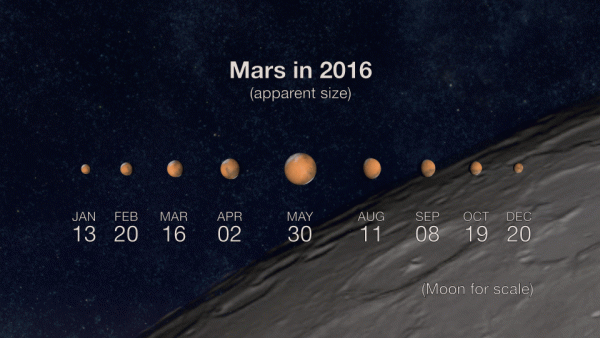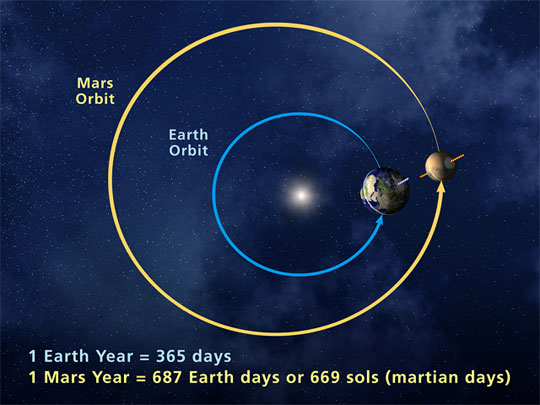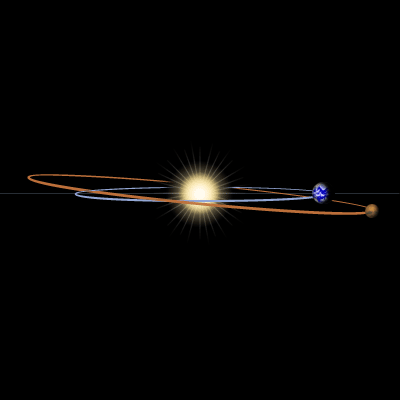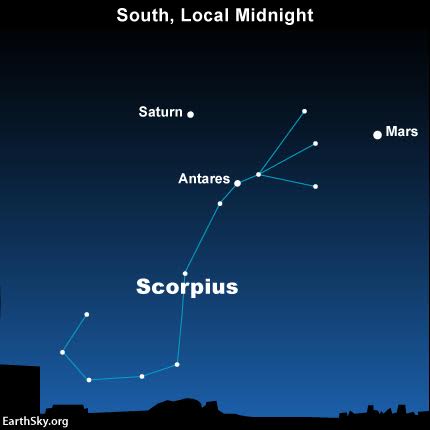
Image at top from the Hubble Space Telescope on May 12.
On May 30, 2016, the red planet Mars comes closer to Earth than it has been since November 2005. It lies 46.8 million miles (75.3 million km) from Earth on this date. This is Mars’ closest point for this year. That’s in spite of the fact that Earth passed between Mars and the sun (the Martian opposition) on May 22.

Why wouldn’t we be closest to Mars on the day we pass between it and the sun?
If both the Earth and Mars circled the sun in perfect circles, and on the same exact plane, the distance between Earth and Mars would always be least on the day of Mars’ opposition. But we don’t live in such a perfect universe. Planets have elliptical orbits and a perihelion (closest point) and aphelion (farthest point) from the sun.
Mars orbit around the sun takes 687 days in contrast to 365 days for Earth. It has a year nearly twice as long as ours. Earth’s closest point to the sun comes yearly, in January. Mars will be closest to the sun next on October 29, 2016.
Right now, with each moment that passes, Mars is still drawing closer to the sun. And that is how its distance from us can be less on May 30 than on May 22, when Earth passed between the sun and Mars.
Generally speaking, Mars is brightest in 2016 from about May 18 to June 3. It is now shining nearly on par with the planet Jupiter, and it’s not very often that Mars can match Jupiter in brilliance!
You might think Mars should be brighter when closest to Earth on May 30 than when it was at opposition on May 22. Although Mars is still plenty bright, it’s a tiny bit fainter than at its May 22 opposition. That’s because of something known as opposition surge. Mars DIRECTLY reflects sunlight back to Earth at opposition, accentuating Mars’ brilliance. Before and after opposition, sunlight is reflected at a slightly slanted angle relative to Earth, thereby reducing Mars’ brightness.
Tonight’s close encounter between the Earth and Mars will be the closest until around the time of the Martian opposition on July 27, 2018.


Although its exact closest point in 2016 is May 30, in contrast to May 22 for opposition, Mars always comes closest to Earth at the vicinity of opposition. The time interval between a Mars’ opposition and its least distance from Earth can be as long as 8.5 days (1969), or as little as 10 minutes (2208 and 2232).
Earth orbits closer to the sun than Mars does, and we move in orbit more swiftly than Mars. Our world gains a lap on Mars on average about every 780 Earth days, or slightly over every two years.

The cycle of Mars’ very best appearances in our sky recurs every 15 to 17 years. Mars will have one of those amazing years in 2018, when Mars comes to within 0.38496 astronomical units of Earth on July 31, 2018. (One astronomical unit = Earth/sun distance.) The last amazing year occurred in 2003, when Mars was only 0.37272 astronomical units from Earth on August 27, 2003.
Earth swings between Mars and the sun every other year, although at progressively later dates. Earth will next lap Mars on July 27, 2018. Its closest approach to Earth that year will be July 31. After that, Earth will next lap Mars on October 13, 2020.

Mars is out almost all night long now. It looks like a bright reddish star, shining with a steadier light than the twinkling stars. Look for Mars in the eastern sky at nightfall – highest in the sky near midnight – and in the west as morning dawn starts to light the sky.
Read more: Close and far Martian oppositions
Bottom line: Mars opposition – when Earth flew between the sun and Mars – was May 22, 2016. But the distance between Mars and Earth is least on May 30, 2016.











